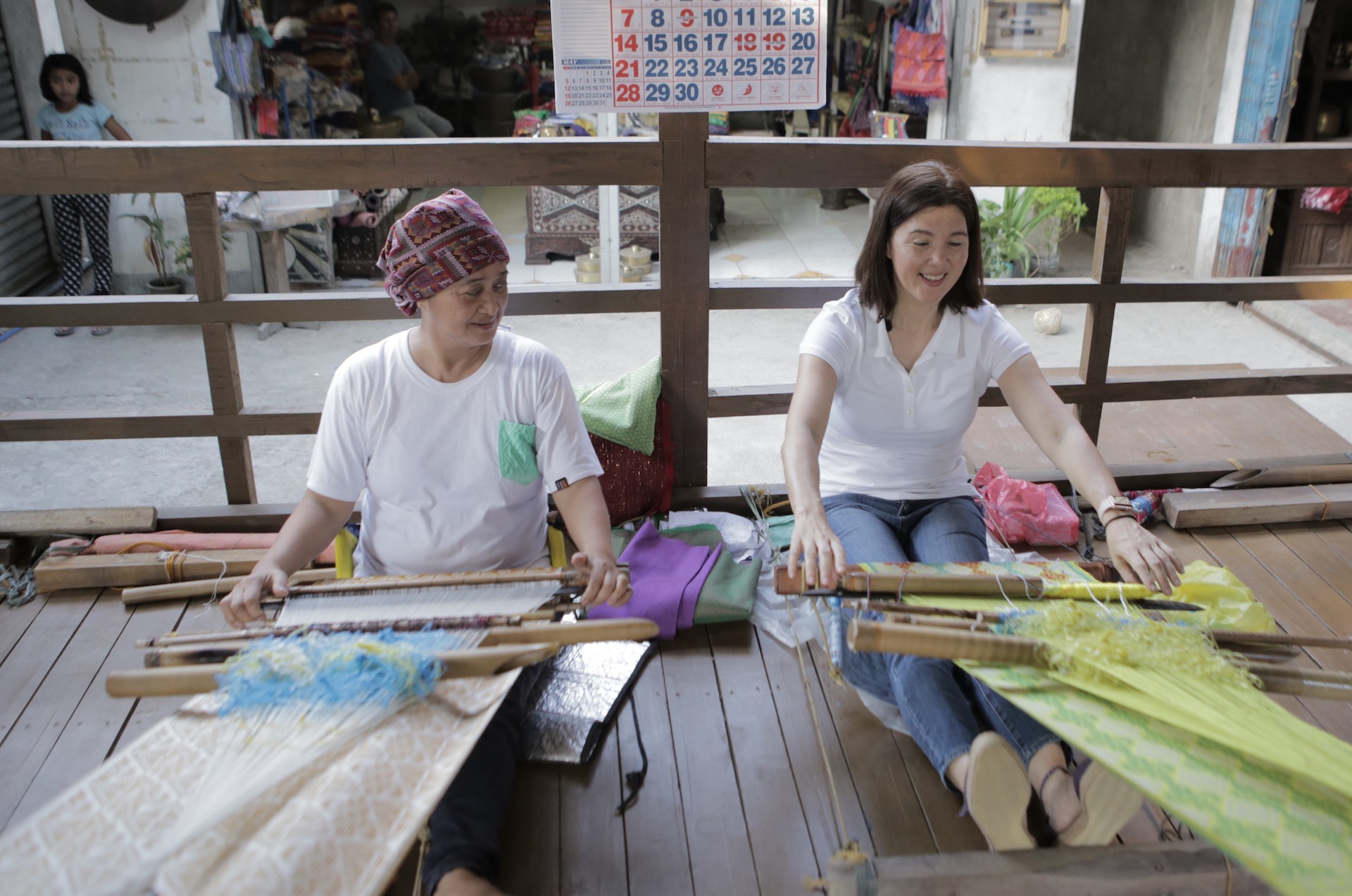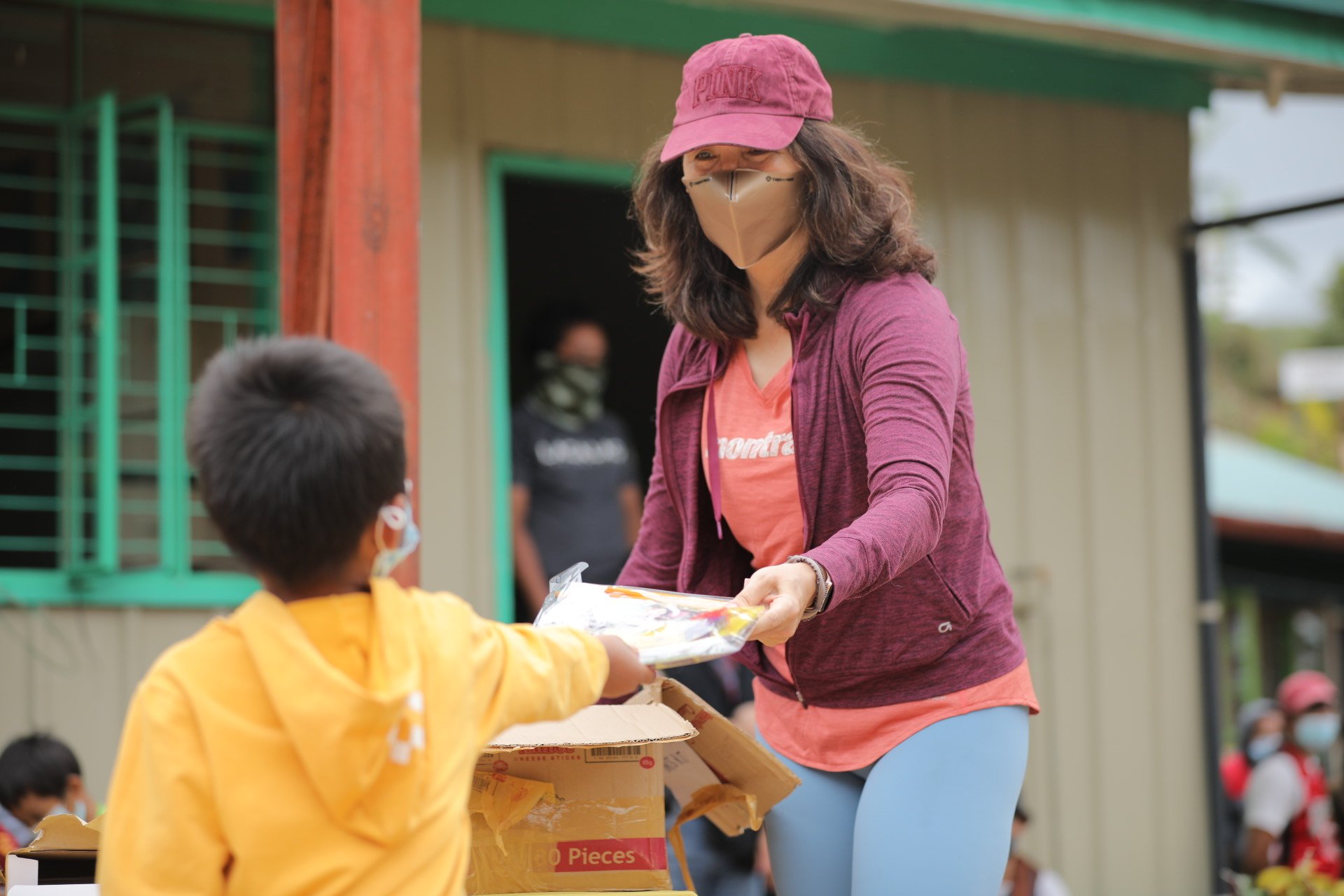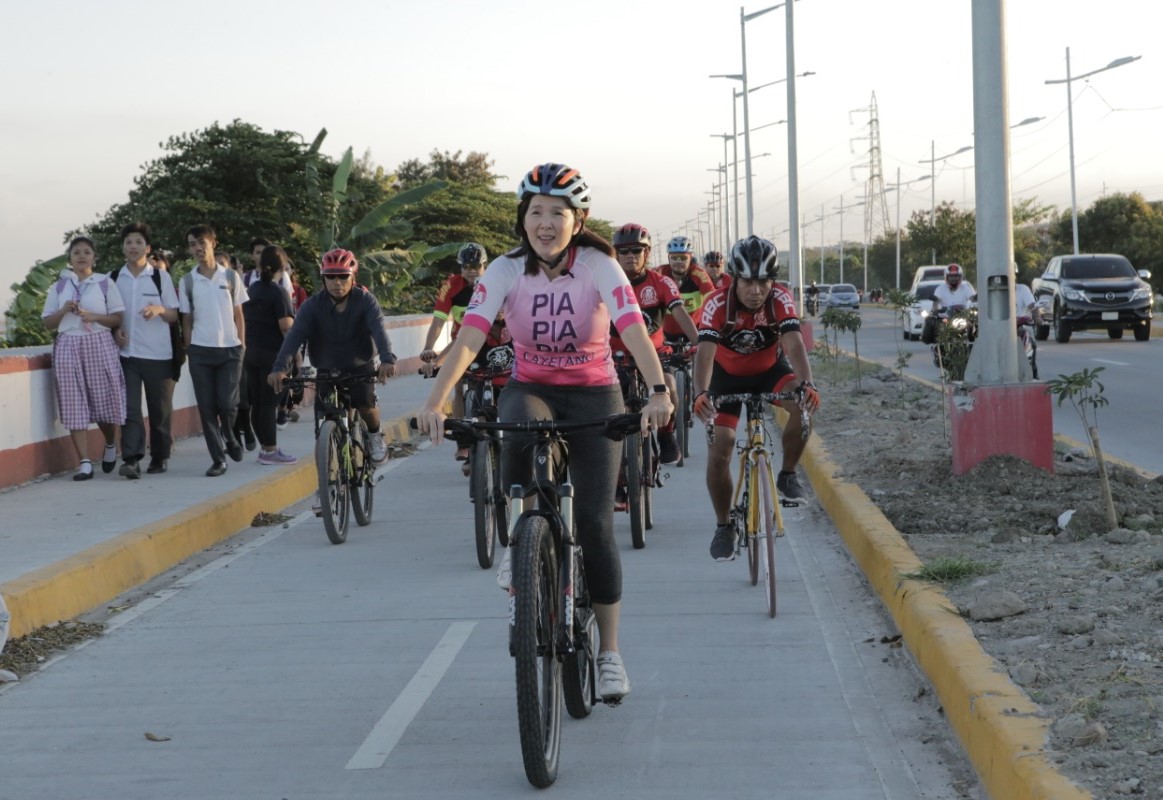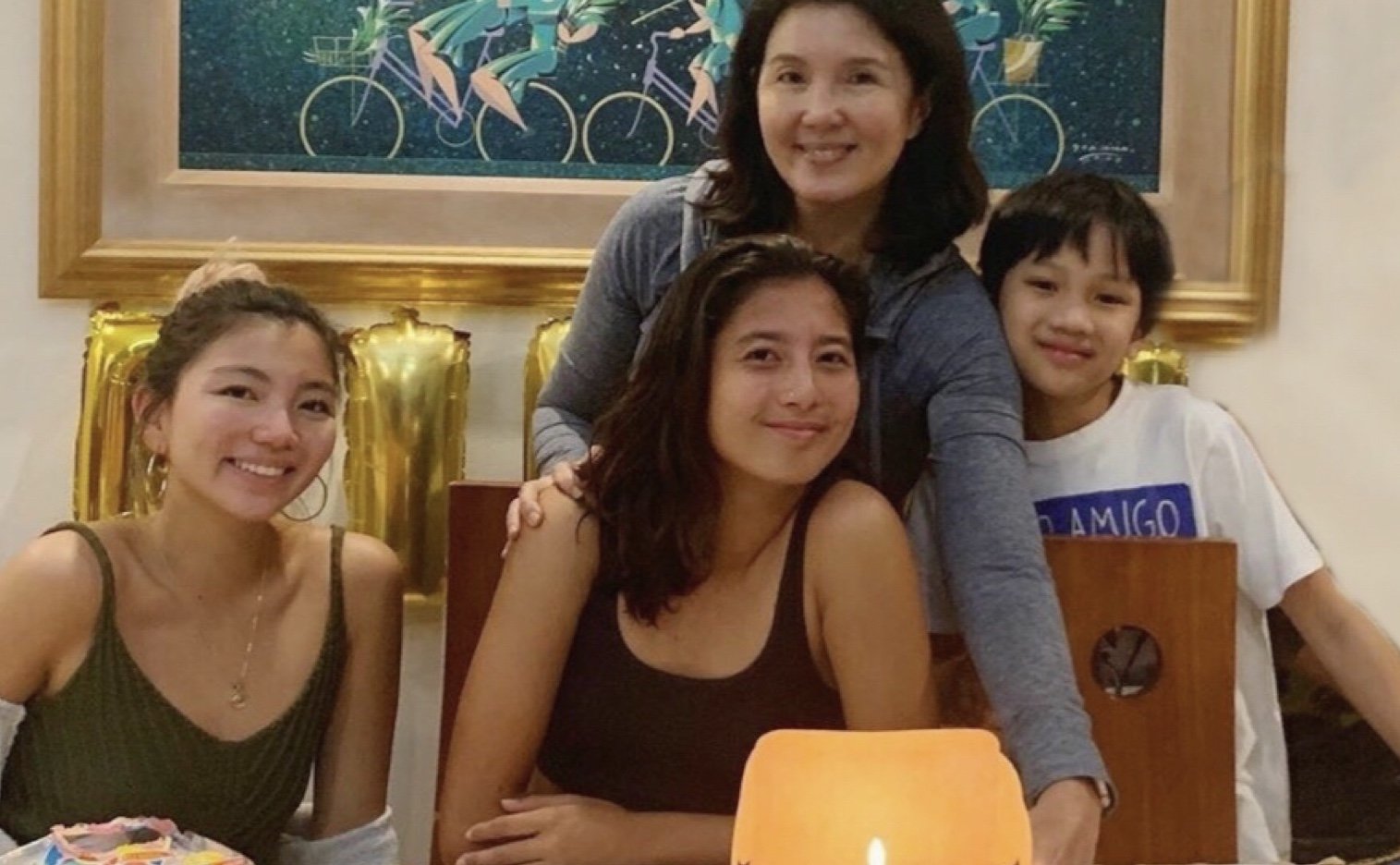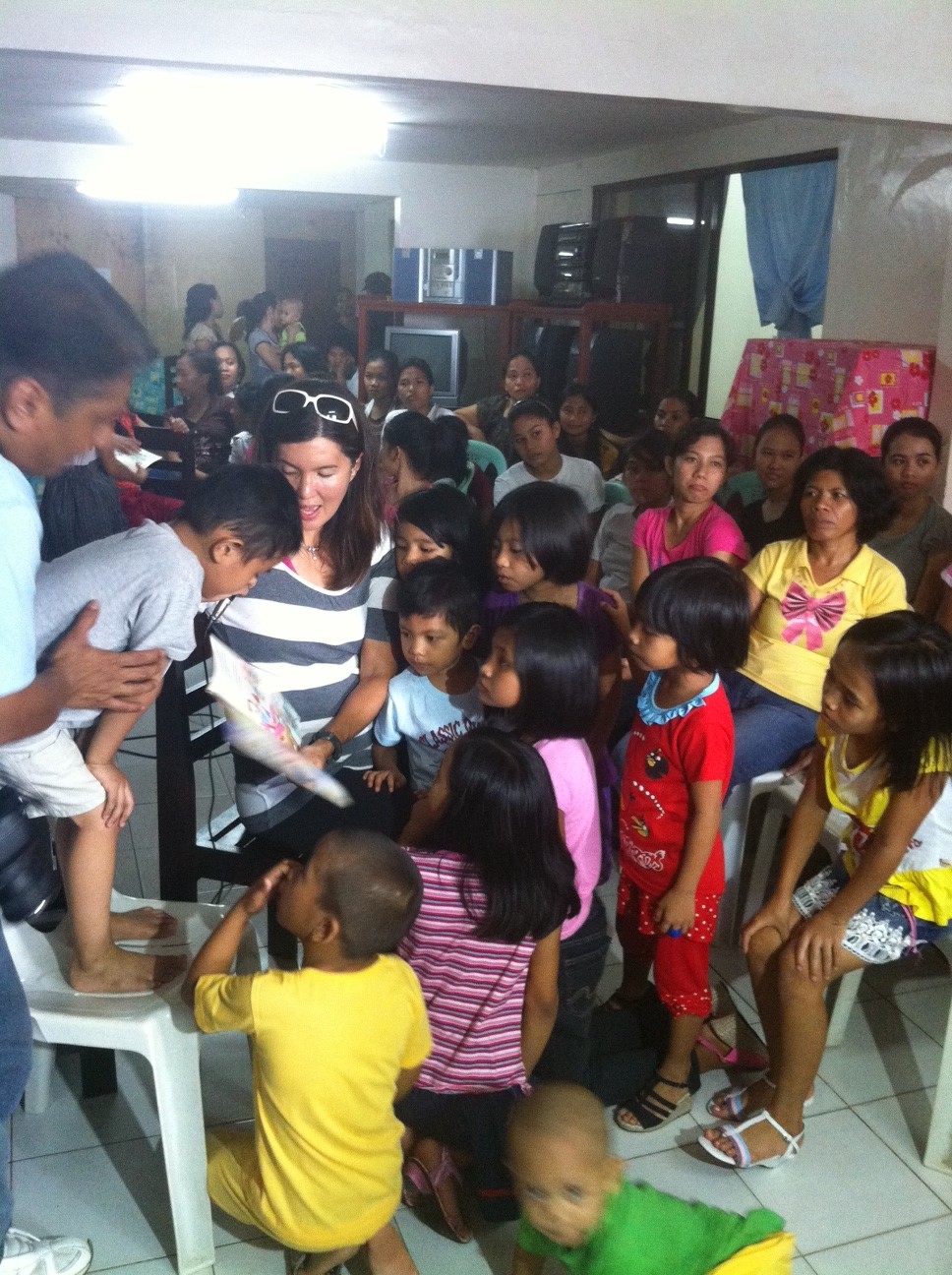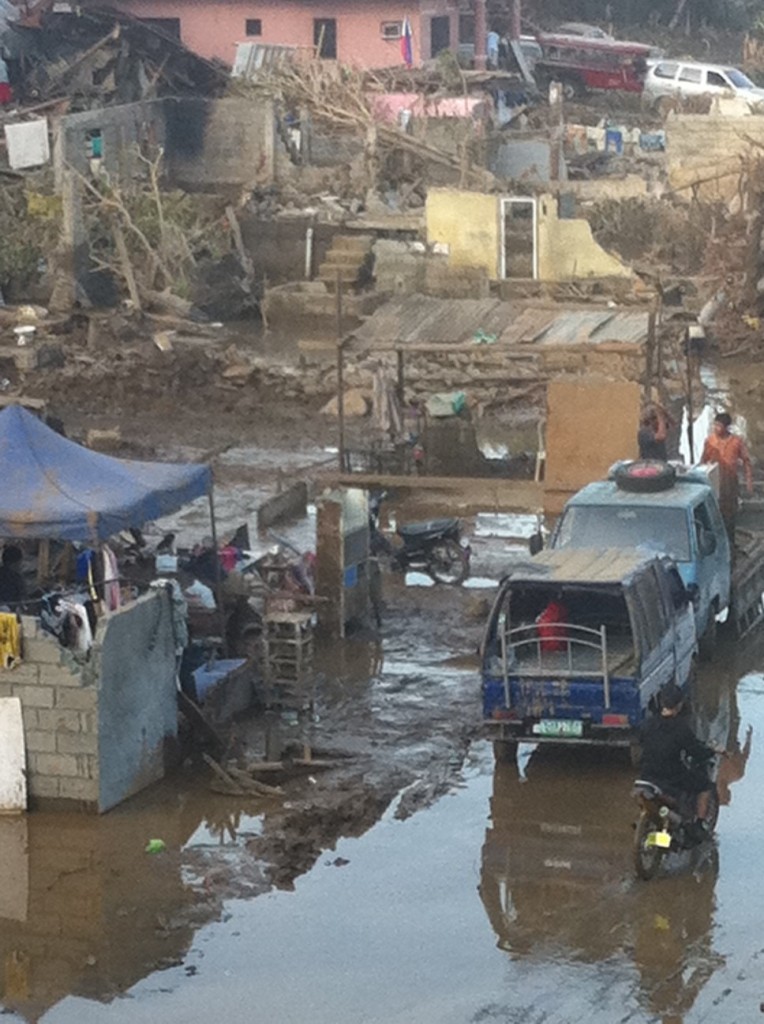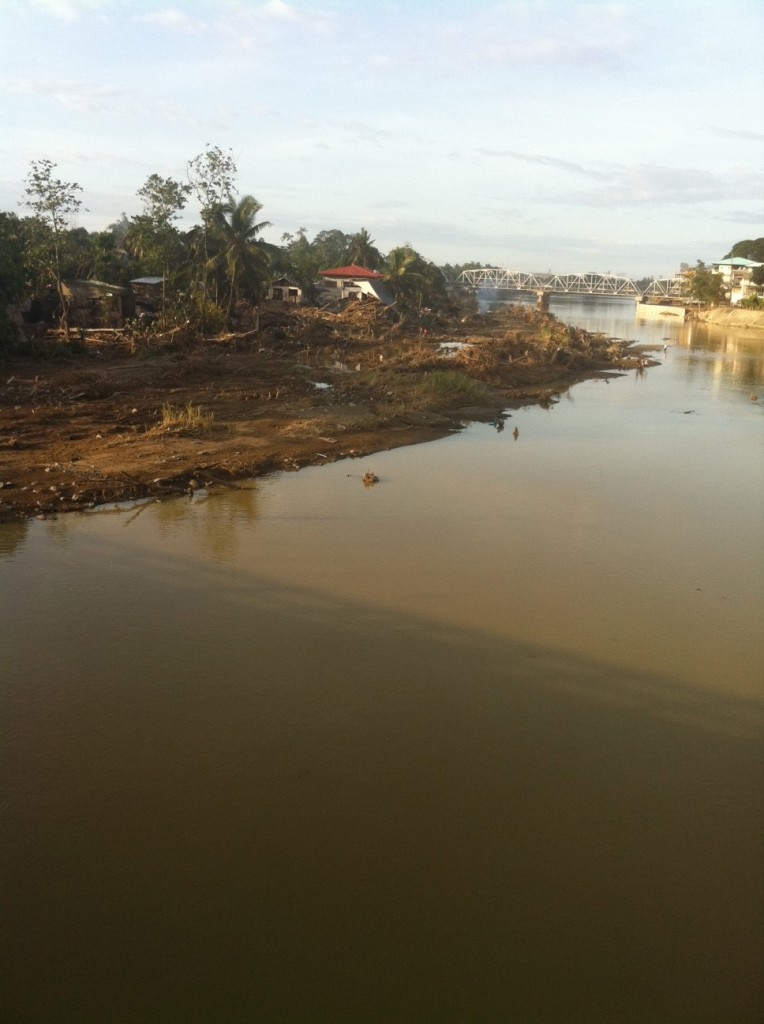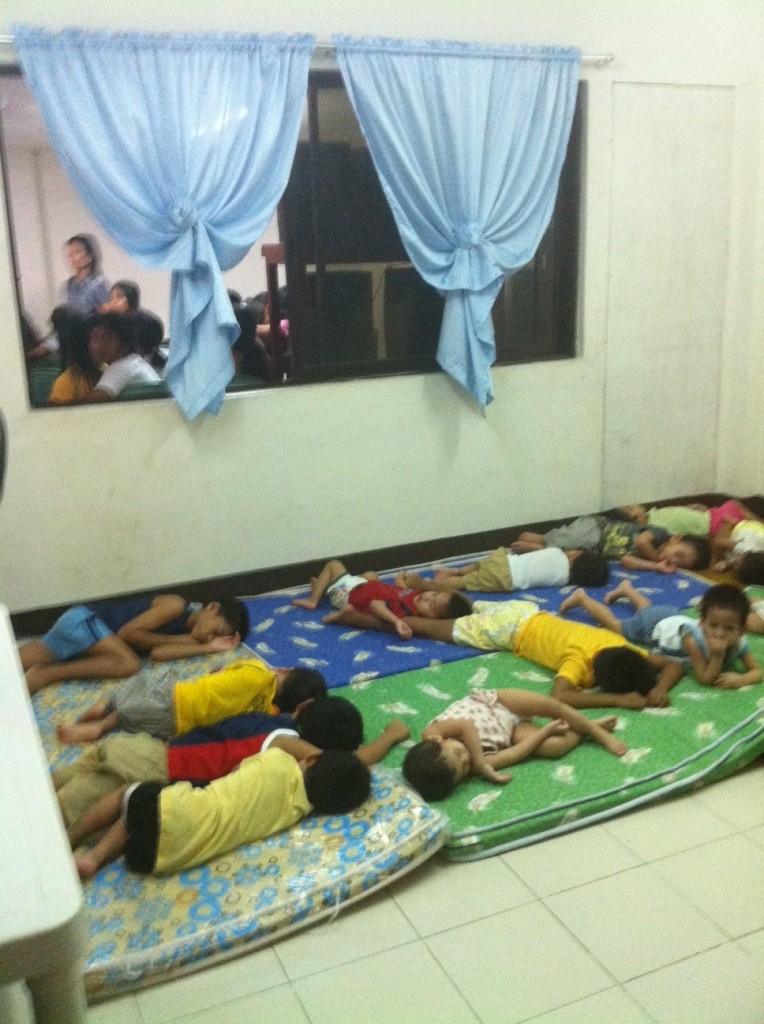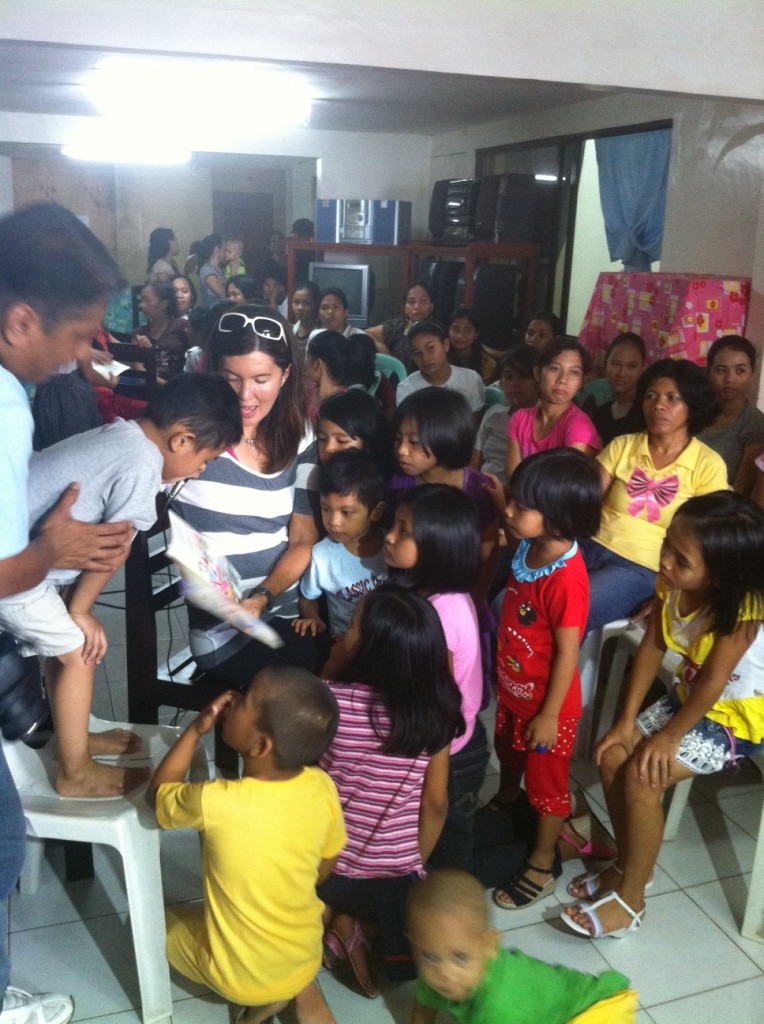I am so proud to wear the Philippine map on my face for Earth Day. Read More
Category: Environment
Legislative Agenda for 2014
On the first Saturday of the year, my amazing Senate legal team indulged me and let me buy them a cup of coffee each Read More
My First Skyrun: Mt Ugo 34km Akyathon
I still had half of the race in front of me. But something about being in the clouds, at the very top just energizes you.
When Disaster Strikes: A visit to CDO after Sendong
Driving from the airport to the Cagayan de Oro City does not instantly reveal the damages brought about by Sendong.
The usual traffic is ever-present, the hustle and bustle of city life goes on. But then you come to the Rotonda Bridge and wonder why there are cars parked along the side of the road and people taking pictures, as if it was a tourist site.
But it’s not a tourist site, it’s a disaster zone. We are standing on the bridge that stands some 10 meters above the Cagayan river. The river is far below. But early Saturday morning, on December 17, 2011, the water rose with such fury that in a matter of minutes, it had passed the height of many one-storey homes and soon after rose higher than the bridge itself.
Today it is calm.
But it has left behind families that are broken, lives that are forever affected. As of this writing, it is reported that 1,018 died, of which 666 are from CDO, 283 from Iligan, the rest from CARAGA and ARMM, 51 missing, 641,098 persons affected. Sendong is the deadliest typhoon to hit Philippines in the last 12 years. (UPDATE: As of December 27, the National Disaster Risk Reduction and Management Council (NDRRMC) reported the death toll at 1,453 already.)
The Western Central School I visited, is almost identical to the many schools that have now been turned into evacuation centers. When I went there, it was home to around 1,300 families. The teachers, Department of Social Welfare and Development (DSWD), local government officials and volunteers do what they can. But the close living conditions and lack of sanitary standards are a time bomb waiting to explode into a health epidemic. We know this story all too well. Disaster strikes, rescue mission are set in place, people are relocated to temporary evacuation centers. Then people start getting sick.
Despite the good intentions of kababayans from all over the country and the world, there is still much that can be done to improve our disaster preparedness. One area, that has long been neglected is our water supply and sewage system. Water is a scarce resource all over the world. Many countries have already invested in developing a reliable water supply, read Singapore’s Water for all story.
We should also seriously start looking at alternatives to our toilets that consume so much water. CDO is paralyzed without fresh water supplies. I made a call to buy CDO and Iligan products to support their rehabilitation, but I learned that many small and medium enterprises (SME’s) don’t have access to clean water and thus, can’t make their products. I’ve seen waterless toilets that work in the Fisherman’s Village in San Fernando, La Union. I am working on a bill to create a national policy on shifting to these kinds of toilets or some equally eco-friendly toilet in all public schools and other public facilities.
Another issue close to my heart is nutrition. It starts with breast feeding. Every effort should be extended to promote breast feeding during disasters. Mother’s milk is the most nutritious and when her breast milk supply is affected, you cut off her baby’s lifeline. There are many health risks associated with the use of unclean water that goes into the preparation of formula milk and other canned milk products. Thus, breast feeding should be encouraged at all cost.
Meanwhile, it’s Christmas. The basic rights of a child, include the right to play and a childhood. I wanted them to have a semblance of Christmas. While visiting at both Western Central and later at the Women’s Center, I read “The Christmas Lantern Trip” story to the children. It’s a story my mom wrote about our search for the perfect “parol.” After we read the story, I encouraged the moms who were there and the older kids to read to the younger kids. I left them a small library of books and had them promise to read every day. I also left them with an assortment of board games, balls and toys that they could play with both indoors and outdoors.
Unfortunately, I didn’t have time to visit Iligan but my staff Faw Maridul is from there and will be going around to various evacuation sites and communities especially those that have not been well served by relief assistance yet. I have already requested for the release of P2.2 Million of my Priority Assistance Funds from DSWD for CDO, Iligan and other towns affected by Sendong. My brother Alan has also allocated the same amount for the affected areas.
Hope lives on through the many people who do not forget CDO and Iligan, and through the volunteers who work day and night to maintain the evacuation centers – the teachers, DSWD officials, local officials. It is my fervent wish and prayer that we all learn from this unfortunate tragedy and together, work towards better disaster prevention and preparedness if we can’t altogether prevent it by being more conscientious of the human activities that contribute to these kinds of natural calamity.
On the Road on Two Wheels
In celebration of carless day, I had mapped out two ways of getting to my office in Pasay City from Alabang sans a car.
A Day with the Running Priest in Hong Kong
How do you spend a day in Hong Kong with the Running Priest?
Contrary to what many of my friends guessed, there was no running (we’ve done that), no mass, no confession (at least not real confession). But it was still a cardio-packed day filled with spiritual reflection, thought-provoking conversation and inspiration.
I went to Hong Kong upon the invitation of Fr Robert Reyes, otherwise known as the Running Priest. A few weeks ago he was at the Senate and told me about his current work with OFW cancer stricken patients and survivors. He wanted me to meet them and see what we could do to help them.

I arrived on Sunday afternoon and went straight to the meeting held in the Philippine Consulate. What transpired was an emotional yet extremely inspirational 2 hour dialogue. There are clear gaps in policies and laws which I am looking into. I will cover this in a separate blog.
The next day, Fr Robert and I agreed, or should I say, connived to show my staff and friends a different side of Hong Kong. I had been to Lamma Island a few years ago and was excited to go back.. We met at Central station and took a ferry to Lamma. That alone was an adventure because I get seasick very easily. Thankfully, it was a short 25 minute trip and I managed a smile soon as my feet touched land.
We were introduced to island life by the sight of bicycles parked by the pier. This is how people got around in Lamma. No cars, just bicycles and a few miniature vehicles that transport goods. Even their ambulance and fire trucks were miniature versions.
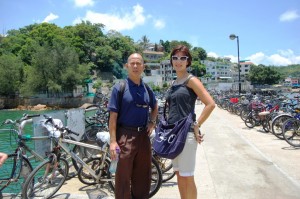
Fr Robert explained to the group that we would walk to the other side of the island. You could hear the sound of resistance to Father’s plan but Father simply said, that’s where we are eating, so if you want to eat, you have to walk… end of story.
After passing thru the commercial area, we found ourselves in the midst of forest cover walking to the beat of bird sounds. Fr Robert pointed out the burial sites which seemed to almost blend with the forest. 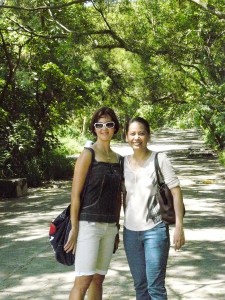
Our first stop was the Portiuncula Monastery. We met the contemplative sisters, headed by Sister Mary Ann. They served us cold orange juice and told us about the distance learning program they offer to OFWs. Sister Mary Ann explained that the objective was to keep the modules as simple and relevant as possible to enable to students to study and comprehend the lessons on their own.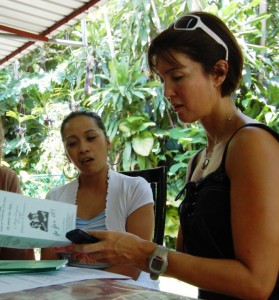
Leslie, an OFW walked me thru the course she was taking. I was amazed! The topics were very relevant to the lives of the OFWs. One sample test was to make a marketing plan for the sale of pre-paid cards to other OFWs.
Our next stop was the taho carinderia. Since the Chinese version of taho is served without sago, I took out my bag of trail mix (nuts and dried fruit) and passed it around to be added as toppings.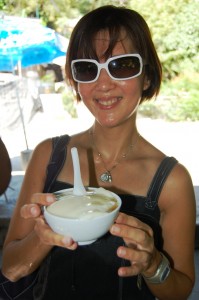
More walking…. Fr. Robert then announced that we would make a stop to visit Joey Dyogi, an OFW who has end-stage kidney failure. Although, he no longer works, Joey is still able to avail of subsidized treatment from the Hong Kong government because he was working as a professional and was a permanent resident at the time he got sick. Contrast this with our domestic helpers who lose their benefits once they are no longer employed and who cannot attain permanent residency status despite the number of years of work.
The main path then led to the beach. After walking in the heat, the urge to jump in the water was almost irresistible. How I wished I had a swimsuit.. I didn’t and neither did anyone else, so we just took more pictures.
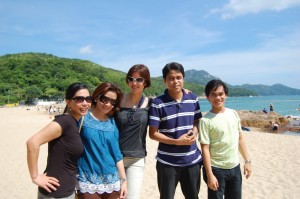
The next segment of our walk was hilly and hot. We entertained ourselves with storytelling, jokes and phone calls from people who Fr Robert wanted me to touch base with.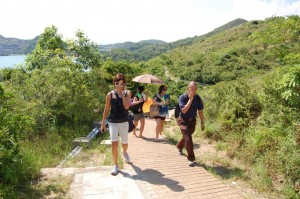
Finally, we reached the other side of the island. We sat down for lunch at 4:30 in the afternoon just in time to catch the 5:30 ferry back to the mainland. 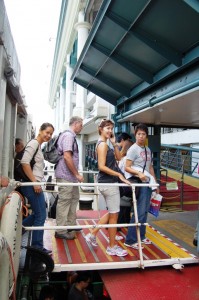
What did we take home from this trip? Because it was led by the Running Priest, our stops were not the usual tourist stops. The people we met and interacted with along the way had stories that affected us, changed us.I think my staff was inspired to take their fitness to the next level. We also felt a deeper appreciation of nature walking thru the well-preserved island devoid of vehicles and traffic. I picked up lessons, I will use to work on legislation and policies for our OFWs.
I plan to go back and take my kids there. They have been on nature walks, they have climbed Mt. Pulag. But I want them to see Lamma Island where it seems modern living and nature have found a way to co-exist.
Solar Power, Mushrooms and Clean Water in Cagayan de Oro
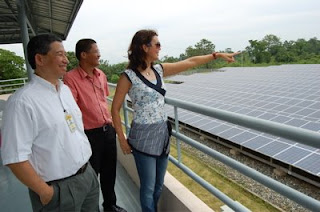 During my trip to Cagayan de Oro a few months ago, I visited the CEPALCO Solar Power Plant, the largest solar power plant in Southeast Asia. It currently serves 900 households in the area. I was surprised how simple it all seemed. As you can see in the pictures, it is simply a large number of solar panels laid out on 2 hectares of land. The sunlight that hits the solar panels are immediately converted into AC voltage and then transmitted to the power grid for distribution.
During my trip to Cagayan de Oro a few months ago, I visited the CEPALCO Solar Power Plant, the largest solar power plant in Southeast Asia. It currently serves 900 households in the area. I was surprised how simple it all seemed. As you can see in the pictures, it is simply a large number of solar panels laid out on 2 hectares of land. The sunlight that hits the solar panels are immediately converted into AC voltage and then transmitted to the power grid for distribution.
The Renewable Energy Bill is one of the priority measures in Congress. I am one of the authors and as such, I have been studying different kinds of renewable energy.
Solar power, like other renewable energy is great because it is environmentally friendly. The problem is the high cost involved. Because of this, solar power is either subsidized or users have to pay a premium. Many are of the view that it is well worth the price, given the savings in environmental and health costs associated with the use of fossil fuel.
 At the end of the day, energy planning is all about maximizing our indigenous sources of energy such as natural gas and oil fields in Palawan (so we reduce our dependence on imported fuel), geothermal energy which is abundant in the Philippines and investing in infrastructure and tapping new technology to developing renewable energy coming from wind, solar, ocean/waves and hydro ( I visited the site of Bangui Windmills last year during a trip to Ilocos Norte. More on this another blog)
At the end of the day, energy planning is all about maximizing our indigenous sources of energy such as natural gas and oil fields in Palawan (so we reduce our dependence on imported fuel), geothermal energy which is abundant in the Philippines and investing in infrastructure and tapping new technology to developing renewable energy coming from wind, solar, ocean/waves and hydro ( I visited the site of Bangui Windmills last year during a trip to Ilocos Norte. More on this another blog)
 My staff along with Mother Earth Foundation held a solid waste management in Barangay Carmen. Participants came from different sectors ”barangay officials, students, business establishments etc. I arrived in time to give a pep talk, answer a few questions and witness the action plan signing wherein each group/sector commited to carry thru the action plan they had written out. Their enthusiasm was contagious. I told them I hoped to see their plans materialize the next time I visit CDO.
My staff along with Mother Earth Foundation held a solid waste management in Barangay Carmen. Participants came from different sectors ”barangay officials, students, business establishments etc. I arrived in time to give a pep talk, answer a few questions and witness the action plan signing wherein each group/sector commited to carry thru the action plan they had written out. Their enthusiasm was contagious. I told them I hoped to see their plans materialize the next time I visit CDO.
 The surprise of this working visit was a stop at the Asian Business Cooperative Academy where I learned about one of the livelihood projects of the students “ the flurutus mushroom which are grown in cylindrical shaped containers filled with sawdust. All one has to do is sprinkle them with water a couple of times a day, wait for them to grow and harvest them. The next batch automatically grows back. I took home some and am hoping they we can harvest our mushrooms soon!
The surprise of this working visit was a stop at the Asian Business Cooperative Academy where I learned about one of the livelihood projects of the students “ the flurutus mushroom which are grown in cylindrical shaped containers filled with sawdust. All one has to do is sprinkle them with water a couple of times a day, wait for them to grow and harvest them. The next batch automatically grows back. I took home some and am hoping they we can harvest our mushrooms soon!
On Clean Water
Clean water is a big problem in our country. Based on a survey of NSO, only about 80% of Filipino households have access to clean water. This means, 17 million Filipinos use and drink water that could make them sick.
Thus,it was with great excitement that I visited the Rio Verde Water facility. Amazing to see how dirty river water that 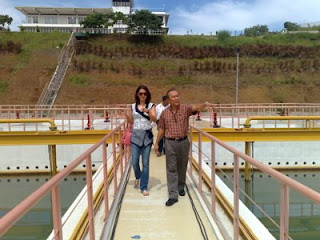 flows
flows
from Mt. Kanlaon is purified through a few touches of the computer. They walked me thru the whole process of receiving the water, flocculation, sedimentation, filtration and finally — clear water ready for distribution. I am told that this meets the WHO standards for drinking water. We hope to see more programs like this.
Rain, Worms and Women Power in Dumaguete
Worms were not part of my agenda in going to Dumaguete. But it found its way into my schedule after City Mayor Agustin Perdices and Governor Emilio Macias III, each told me how they are using worms to create organic fertilizer. The process is fairly simple: Mix manure, organic products like leaves and a handful of worms in a big sack. The worms eat and excrete and in a few weeks, voila, you have organic fertilizer. The goal is to get more farmers to make their own organic fertilizer instead of buying commercial fertilizers which are much more expensive and have chemical ingredients.
My staff actually had been there for the last three days conducting seminars on breast feeding and women empowerment.
I arrived on a rainy Saturday afternoon. Aren’t rainy Saturday afternoons just perfect for going to sleep? But this was a working Saturday for me and I was scheduled to meet the governor and get a tour of the provincial hospital.
The governor, it turns out is a PGH trained surgeon, a passionate healthcare advocate who shared a lot of his ideas about devolved health care, its problems and possible solutions. It was great to meet him and the medical staff of the hospital. I hope to use their experiences in reviewing our health care policies.
From health care Negros Oriental style, I got a taste of women power, Siliman University style. I met their student council, headed by SC President Stacy Danika Sia Alcantara. Wow! What an energetic talented group of young women, to say the least. They proudly told me that their school is very gender sensitive and has always had a strong women studies department, that the young men who enter the University are soon enough indoctrinated into a lifestyle that is gender equal in all aspects. More power girls. I promised to write a future entry on women empowerment and the girls promised to contribute?
Later that evening, I met with Green Alert Negros, who expressed their concern about the plans to cut thousand of trees and develop part of Mt Kanlaon as a source of geothermal energy. I actually climed Mt Kanlaon years ago and was quite familiar with the affected area. But more importantly Mt. Kanlaon is a natural park protected by law, rich in biodiversity and is home to many endemic species.
Next day, I woke up to a dark morning, with tree branches swaying from the strong winds.. It looked like rain was inevitable, but in fact, shortly after 5 am, the sky started to lighten up.. Ani and I ran straight from our hotel to the starting line where we joined thousands of runners who like us, got up at dawn for the fun of running in one of the 3 distances of the Milo Maratthon series –3k, 5k and 21k.
I joined the 21k run which took us along Rizal Boulevard, right by the Tanon Strait which was a beautiful site. Then we turned into a side road and went thru very pleasant countryside, where the locals lined the streets to watch us go by.
The exciting part of every run for me is seeing the strong women runners race. We had a chance to chat after the awarding ceremonies. They come from all backgrounds, mothers, students, teens and women in their 40s, all fast runners who outrun most men!

In just about 24 hours from the time I got to Dumaguete, I was homebound. I didn’t get much of a chance to explore the beautiful city, but thanks to the local government officials, the locals, my staff and everyone who gave us some of their valuable time, we had a productive and fulfilling trip.
What Have You Done Today to Make You Feel Proud?
This is a refrain from a song in my ipod shuffle, which I hear a couple of times a week when I’m out biking or running. I often ponder on that song and wonder what I have done to make, not only myself proud, but my parents, and the people around me? I wonder if people ever ask themselves what they have done to be proud of this country.

I had planned on posting this on June 12 in celebration of independence day, but as usual got caught up with a billion things. Delayed as it is, I think we should all ask ourselves that question. As a human being, as a God fearing Filipino, does my existence contribute to the general welfare of the people around me, my country? Do I complain about what’s wrong with this country before asking myself what have I done to make it better?
It’s a serious question but depending on your mood, you can answer it lightly or with as much as serious thought as you wish to put into it.
I’m choosing to answer this from a personal point of view, as in what I am personally proud of, and also collectively, as in my views on what we as a people can be proud of¦
1. As a mother, I am proudly raising my two daughters to be responsible citizens who care about others and the environment we live in. During the summer, I had each of them list their energy-saving tips and ways of saving the environment (subject of a future blog). I try to expose them to all aspects of Filipino life, so they understand that there is still so much poverty around us and that each of us can do something to make a difference. I want them to be cognizant of the fact that life is tough for many. Their baby brother Gabriel did not have an easy life. He could not breath without assistance, could not eat without a tube in his mouth.
So every year, we celebrate Gabriel’s life with a 12-hour fundraising and awareness multi-sport event for the benefit of children with disabilities (www.gabrielsymphony.com). I hope my daughters will grow up to be compassionate Filipinos who care about the well-being of others. 
2. We Filipinos take pride in our love of family and respect for our elders. We take care of our parents and grandparents. We are proudly the best caregivers in the world, from doctors to nurses to caregivers; our professionals are sought worldwide. But government must not lose focus on the fact that as we supply the world with our human health care professionals, we must also plan on how to take care of our own. These were some of the issues I have been working on locally and abroad, most recently at the Inter-Parliamentary Union held in Cape Town last April (future blog). We need to focus on improving access to healthcare for our own people.
3. I am proudly promoting the cause of health and fitness. I cannot talk enough about how important it is for each one of us to be responsible for our own health. It does not come for free. One must eat well, exercise and live a healthy life. For more on my health agenda, visit my official website www.senatorpiacayetano.com

4. I am proudly fighting for a greener cleaner Philippines. We are working on the passage of the sustainable forest management bill. We are also trying to increase awareness and compliance with our solid waste management law (RA 9003). More and more Filipinos are aware of the need to segregate waste. And yet according to Ecowaste Coalition, of the 42,000 barangays only 2,000 have a segregation program and an MRF (material recovery facility). Is there one in your barangay?
5. We were all born into this country that is rich in natural resources. I am proudly sponsoring bills to declare many of these areas as protected areas. I have called on Filipinos to vote for Tubattaha and our other natural treasures on www.new7wonders.com. But what have we each done to contribute to the preservation of these Philippine wonders? There are rivers and mountains that need to be restored and rehabilitated all over the country. You can each take up a cause close to your heart. (there are a lot of causes, more on these in future blogs)
6. I am proudly working towards the attainment of our Millennium Development Goals in 2015. We need to decrease our infant, child and maternal mortality rates. Today, there are still many women in the rural areas who die of childbirth, simply because they do not have access to a childbirth attendant (a certified midwife, nurse or doctor). Many newborns are underweight, malnourished and sickly because their mothers did not have pre-natal care. Access to prenatal care is vital.
7. I am proudly promoting breastfeeding. Many mothers still do not know that they are capable of exclusively feeding their baby for the first six months with their breastmilk without the need of supplementing with formula milk or food (visit my breastfeeding blog on www.bestforbabies.wordpress.com)

8. Filipino women are the bedrock of our homes and our society. I proudly support women empowerment thru my Pinay In Action programs. Every year, we celebrate Women’s Month in March with an all-women’s run and expo. My team, headed by national team tri champ Ani de Leon goes around the country giving talks on empowerment to young girls and teaching them how to run.
9. I proudly support the Philippine teams that compete in international competitions. These athletes work hard, despite the limitations in training facilities, financial and sometimes even moral support. They persevere and excel..and bring glory to our country.
10. I love to race. I join triathlons, duathlons and marathons whenever I can. It is my pride and privilege to carry the Philippine flag.

I could spend a whole day on this list. But the point of this exercise is to get people to think, just as the song goes, “what have you done today to make you feel proud?
My kind of Jeep
Finally a road vehicle that excites me…I’m not into cars..fast cars, slow cars, they don’t really matter to me.. I cant distnguish one brand from another. I describe cars by their size and color..
Needless to say, new vehicles on the road do not grab my attention…except for one…
As I was leaving the provincial capitol of Negros Oriental in Bacolod City, my staff reminded me that to get to my next meeting, I would be riding the latest jeepney to hit the streets of bacolod.. I should mention at this point, that if there is any public utility vehicle that would pique my curiosity it would be the jeep.

For one, I love looking at the art work found on the sides of jeepneys, especially the very colorful ones and those that depict images related to our culture or beautiful places in our country. And second, as a child, my mom used to take me to the Intercon Hotel jeepney coffee shop where we would sit in the jeep and eat merienda..
But back to the jeep in Bacolod..This jeep is super special because it does not run on gasoline or diesel! It runs on electricity. Like any electronic gadget, you just have to plug it into an outlet, charge for a few hours and its good to go!…
Its called the E-Jeep. Its a joint project of the Green Renewable Independent Power Producer, Inc. (GRIPP), Greenpeace and Solar Electric Company.
Here’s another exciting bit of info about this jeep and the vision of the groups behind the e-jeep. The intention is to use energy from biodegradable waste from the city’s wet markets to power not just the jeep but an environmental-friendly mass transport system.
So, we address the problem of air pollution and solid waste management at the same time!
cool diba?
At present, the e-jeep is being test run in Bacolod and Makati. Since it only runs at 40kph, it is meant to ply small busy roads where the speed is usually slow anyway. Perfect for commuters inside a subdvision or short destinations. For efficient operations, we are told that the plan is to build stations where the jeeps can be charged, so instead of gas stations, we will have charging stations..
Needless to say, I enjoyed my short but extremely pleasant jeepney ride. Oh, by the way, it also is super quiet. No rumbling engines, no noisy tambutso!

I am really hoping to see more innovative environment-friendly projects like this.
Next thing you know, you’ll be calling your mom or boyfriend and saying, sorry Im late, no low bat yung jeep na sinasakyan ko!

